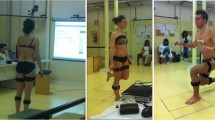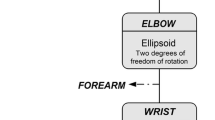Abstract
A variability analysis of upper limb therapeutic movements using wearable inertial sensors is presented. Five healthy young adults were asked to perform a set of movements using two sensors placed on the upper arm and forearm. Reference data were obtained from three therapists. The goal of the study is to determine an intra and inter-group difference between a number of given movements performed by young people with respect to the movements of therapists. This effort is directed toward studying other groups characterized by motion impairments, and it is relevant to obtain a quantified measure of the quality of movement of a patient to follow his/her recovery. The sensor signals were processed by applying two approaches, time-domain features and similarity distance between each pair of signals. The data analysis was divided into classification and variability using features and distances calculated previously. The classification analysis was made to determine if the movements performed by the test subjects of both groups are distinguishable among them. The variability analysis was conducted to measure the similarity of the movements. According to the results, the flexion/extension movement had a high intra-group variability. In addition, meaningful information were provided in terms of change of velocity and rotational motions for each individual.












Similar content being viewed by others
References
de los Reyes-Guzmán, A., Dimbwadyo-Terrer, I., Trincado-Alonso, F., Monasterio-Huelin, F., Torricelli, D., Gil-Agudo, A., Quantitative assessment based on kinematic measures of functional impairments during upper extremity movements: A review. Clin. Biomech. 29(7):719–7-27, 2014.
Kostić, M. D., and Popović, M. D., The modified drawing test for assessment of arm movement quality. J. Autom. Control 21(1):49–53, 2013.
Wolf, S. L., Winstein, C. J., Miller, J. P., Taub, E., Uswatte, G., Morris, D., et al., Effect of constraint-induced movement therapy on upper extremity function 3 to 9 months after stroke: the EXCITE randomized clinical trial. JAMA 296(17):2095–2104, 2006.
Gama, A. D., Chaves, T., Figueiredo, L., Teichrieb, V.: Guidance and movement correction based on therapeutics movements for motor rehabilitation support systems. In: 2012 14th Symposium on Virtual and Augmented Reality (SVR), pp. 191–200 (2012)
Houmanfar, R., Karg, M., Kulic, D., Movement analysis of rehabilitation exercises: Distance metrics for measuring patient progress. IEEE Systems Journal PP(99):1–12, 2014.
Mancini, M., and Horak, F. B., The relevance of clinical balance assessment tools to differentiate balance deficits. Eur. J. Phys. Rehab. Med. 46(2):239–248, 2010.
Guerra Filho, G. B.: A sensory-motor linguistic framework for human activity understanding. Ph.D. Dissertation. University of Maryland at College Park, College Park, MD, USA (2007)
Lum, P. S., Burgar, C. G., Shor, P. C., Majmundar, M., Van der Loos, M., Robot-assisted movement training compared with conventional therapy techniques for the rehabilitation of upper-limb motor function after stroke. Arch. Phys. Med. Rehab. 83(7):952–959, 2002.
Kutner, N. G., Zhang, R., Butler, A. J., Wolf, S. L., Alberts, J. L., Quality-of-life change associated with robotic-assisted therapy to improve hand motor function in patients with subacute stroke: A randomized clinical trial. Phys. Ther. 90(4):493–504, 2010.
Lo, A. C., Guarino, P. D., Richards, L. G., Haselkorn, J. K., Wittenberg, G. F., Federman, D. G., Peduzzi, P., Robot-assisted therapy for long-term upper-limb impairment after stroke. New England J. Med. 362 (19):1772–1783, 2010.
Wei, X. J., Tong, K. Y., Hu, X. L., The responsiveness and correlation between Fugl-Meyer assessment, motor status scale, and the action research arm test in chronic stroke with upper-extremity rehabilitation robotic training. Int. J. Rehab. Res. 34(4):349–356, 2011.
Quintana, G. E., Sucar, L. E., Azcarate, G., Leder, R.: Qualification of arm gestures using hidden Markov models. In: 8th IEEE International Conference on Automatic Face & Gesture Recognition, 2008. FG’08, pp. 1–6 (2008)
van Andel, C. J., Wolterbeek, N., Doorenbosch, C. A., Veeger, D. H., Harlaar, J., Complete 3D kinematics of upper extremity functional tasks. Gait Post. 27(1):120–127, 2008.
Butler, E. E., Ladd, A. L., Louie, S. A., LaMont, L. E., Wong, W., Rose, J., Three-dimensional kinematics of the upper limb during a reach and grasp cycle for children. Gait Post. 32(1):72–77, 2010.
Jaspers, E., Feys, H., Bruyninckx, H., Harlaar, J., Molenaers, G., Desloovere, K., Upper limb kinematics: Development and reliability of a clinical protocol for children. Gait Post. 33(2):279–285, 2011.
Uswatte, G., Foo, W. L., Olmstead, H., Lopez, K., Holand, A., Simms, L. B., Ambulatory monitoring of arm movement using accelerometry: An objective measure of upper-extremity rehabilitation in persons with chronic stroke. Arch. Phys. Med. Rehab. 86(7):1498–1501, 2005.
van der Pas, S. C., Verbunt, J. A., Breukelaar, D. E., van Woerden, R., Seelen, H. A., Assessment of arm activity using triaxial accelerometry in patients with a stroke. Arch. Phys. Med. Rehab. 92(9):1437–1442, 2011.
Parnandi, A., Wade, E., Matari, M.: Motor function assessment using wearable inertial sensors. In: 2010 Annual International Conference of the IEEE of Engineering in Medicine and Biology Society (EMBC), pp. 86–89 (2010)
Zhang, M., Lange, B., Chang, C. Y., Sawchuk, A. A., Rizzo, A. A.: Beyond the standard clinical rating scales: Fine-grained assessment of post-stroke motor functionality using wearable inertial sensors. In: 2012 Annual International Conference of the IEEE of Engineering in Medicine and Biology Society (EMBC), pp. 6111–6115 (2012)
Strohrmann, C., Labruyère, R., Gerber, C. N., van Hedel, H. J., Arnrich, B., Tröster, G., Monitoring motor capacity changes of children during rehabilitation using body-worn sensors. J. Neuroeng. Rehab. 10(83), 2013.
Guneysu, A., Arnrich, B., Ersoy, C.: Children’s rehabilitation with humanoid robots and wearable inertial measurement units. In: 2015 9th International Conference on Pervasive Computing Technologies for Healthcare (PervasiveHealth), pp. 249–252 (2015)
Muda, L., Begam, M., Elamvazuthi, I.: Voice recognition algorithms using mel frequency cepstral coefficient (MFCC) and dynamic time warping (DTW) techniques. arXiv preprint arXiv:1003.4083 (2010)
Keogh, E., and Ratanamahatana, C. A., Exact indexing of dynamic time warping. Knowl. Inf. Syst. 7(3): 358–386, 2005.
Han, J., Kamber, M., Pei, J.: Data Mining: Concepts and Techniques: Concepts and Techniques. Elsevier (2011)
Quinlan, J. R.: C4. 5: Programs for Machine Learning. Elsevier (2014)
Agresti, A., and Kateri, M.: Categorical Data Analysis. Springer Berlin Heidelberg, pp. 206–208 (2011)
Brückner, H. P., Krüger, B., Blume, H., Reliable orientation estimation for mobile motion capturing in medical rehabilitation sessions based on inertial measurement units. Microelectron. J. 45(12):1603–1611, 2014.
Wise, C.: Orthopaedic Manual Physical Therapy From Art to Evidence. F.A. Davis (2015)
Zhang, Y., Qiu, M., Tsai, C., Hassan, M. M., Alamri, A., Health-CPS: Healthcare cyber-physical system assisted by cloud and big data. IEEE Syst. J. PP(99):1–8, 2015.
Chen, M., Zhang, Y., Li, Y., Hassan, M. M., Alamri, A., AIWAC: Affective interaction through wearable computing and cloud technology. IEEE Wire. Commun. 22(1):20–27, 2015.
Acknowledgments
This work is supported by the Mexican National Council for Science and Technology, CONACYT (grant number 271539/224405); and by the UBIHEALTH project, FP7-PEOPLE-2012-IRSES, European Commission (grant 316337).
Author information
Authors and Affiliations
Corresponding author
Additional information
This article is part of the Topical Collection on Mobile & Wireless Health.
Appendix: Time-domain features
Appendix: Time-domain features
The time-domain features are divided into two groups: central tendency (Eqs. 6 and 7) and dispersion (Eqs. 8–12), as described below.
In all the formulas detailed below: n is the size of the signal X, x is a value of X, th indicates the th-term of the ordered time serie X, and Q1 and Q3 are the lower and upper quartile of X.
-
Arithmetic mean (\(\bar {x}\)):
$$ \bar{x}=\frac{x_{1}+x_{2}+...+x_{n}}{n} $$(6) -
Median (f(x)):
$$ f(x) = \left\{\begin{array}{llllllll} \left( \frac{n+1}{2}\right)^{th} term & \text{when}\, n\, \text{is odd}\\ \frac{\left( \frac{n}{2}\right)^{th} term+\left( \frac{n+1}{2}\right)^{th} term}{2} & \text{when}\, n\, \text{is even} \end{array}\right. $$(7)
-
Standard deviation (σ):
$$ \sigma=\sqrt{\frac{1}{n}\left[\left( x_{1}-\bar{x}\right)^{2}+\left( x_{2}-\bar{x}\right)^{2}+...+\left( x_{n}-\bar{x}\right)^{2}\right]} $$(8) -
Variance (σ 2):
$$ \sigma^{2}=\frac{1}{n}\left[\left( x_{1}-\bar{x}\right)^{2}+\left( x_{2}-\bar{x}\right)^{2}+...+\left( x_{n}-\bar{x}\right)^{2}\right] $$(9) -
Root mean square (rms):
$$ rms=\sqrt{\frac{1}{n}\left( {x_{1}^{2}}+{x_{2}^{2}}+...+{x_{n}^{2}}\right)} $$(10) -
Interquartile range (iqr):
$$ iqr=Q_{3}-Q_{1} $$(11) -
Mean absolute deviation (mad):
$$ mad=\frac{1}{n}\left[\mid x_{1}-\bar{x} \mid +\mid x_{2}-\bar{x} \mid +...+\mid x_{n}-\bar{x} \mid \right] $$(12) -
Minimum is the smallest value of the sample
-
Maximum is the largest value of the sample
Rights and permissions
About this article
Cite this article
López-Nava, I.H., Arnrich, B., Muñoz-Meléndez, A. et al. Variability Analysis of Therapeutic Movements using Wearable Inertial Sensors. J Med Syst 41, 7 (2017). https://doi.org/10.1007/s10916-016-0645-8
Received:
Accepted:
Published:
DOI: https://doi.org/10.1007/s10916-016-0645-8




